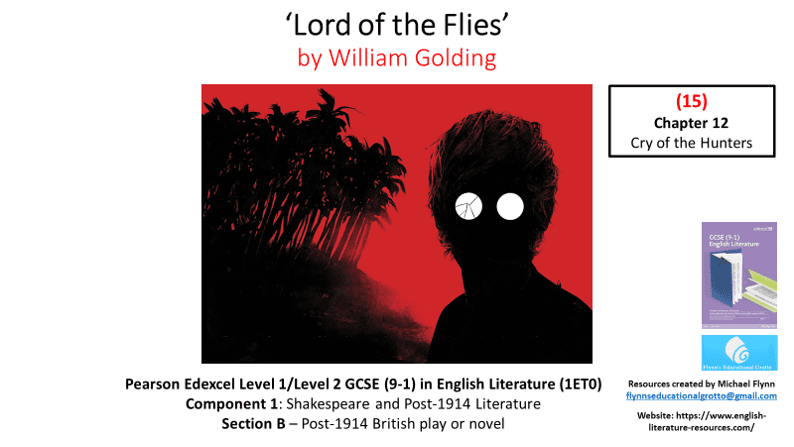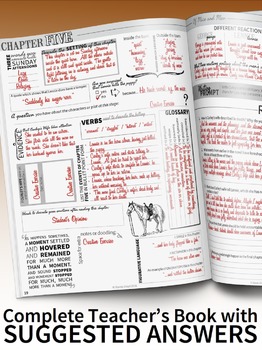Imagine a group of British schoolboys stranded on a deserted island, their civilization stripped away. What would happen? Would they create a utopian society or descend into savagery? William Golding’s “Lord of the Flies” examines these chilling and timeless questions, forcing us to confront the dark side of human nature. Navigating the complex themes and symbolism of this novel can be daunting, but fear not! This article will serve as your guide, leading you through the labyrinthine world of “Lord of the Flies” with a comprehensive student workbook.

Image: lessonplanned.co.uk
This “Lord of the Flies” workbook isn’t just for struggling students; it’s about unraveling the richness of Golding’s masterpiece together. Whether you’re tackling it in the classroom or exploring its depths independently, this workbook is your key to unlocking the novel’s profound messages. It will provide you with the tools to analyze the characters, dissect the plot, and dig deep into the symbolism that paints the canvas of Golding’s narrative.
Understanding the Foundation: A Historical Context
To truly grasp the power of “Lord of the Flies,” understanding its historical context is essential. The novel was published in 1954, during a period of immense societal unease. The horrors of World War II still loomed large, casting a shadow on the potential of humanity. Golding, having experienced the barbaric reality of war firsthand, sought to explore the potential for savagery that exists within us all. He wanted to challenge the naive optimism that prevailed in the wake of war, warning that human nature is capable of great darkness.
With this understanding in mind, the characters of Ralph, Piggy, Jack, and the rest of the boys are not simply fictional creations; they represent archetypal figures embodying different facets of human nature. Ralph, the elected leader, symbolizes order and reason, striving to maintain a semblance of civilization. Piggy, with his intellect and reliance on logic, highlights the importance of knowledge and rational thought. However, Jack represents the primal instincts lurking beneath the surface, wielding the power of charismatic leadership to stir the boys towards savagery.
Exploring the Plot: A Journey into Darkness
The initial hope of rescue fuels a collective effort to maintain order on the island. The boys establish rules, build a fire signal, and work together to survive. But as time passes, the allure of freedom and the seductive power of primitive desires begin to take hold. Jack seizes control, manipulating the boys’ fear and aggression, gradually leading them down a path of chaos and violence.
This descent into savagery is not a sudden transformation but a gradual process. It’s a subtle erosion of reason and morality that, unfortunately, resonates with real-world events. The boys’ actions begin to mirror the destructive tendencies that can be seen in mob mentality, political unrest, and the rise of authoritarianism.
The Power of Symbolism: Unraveling the Deeper Meaning
Golding uses symbols to weave a complex tapestry of meaning throughout the narrative. The island itself is a powerful symbol, serving as a microcosm of the world, a blank slate on which the boys’ primal instincts are played out. The conch shell, wielded by Ralph as a symbol of authority, represents order, reason, and democracy. But its destruction marks the demise of civilization and the triumph of savagery.
The fire, initially intended to signal for rescue, becomes a tool for destructive power. It symbolizes the destructive potential of unchecked ambition and the boys’ inability to control their own primal urges. The Lord of the Flies, the pig’s head on a stick, is perhaps the most haunting symbol in the novel. It represents the evil lurking within, the beast that haunts their minds and ultimately compels them to act out their darkest desires.

Image: www.teacherspayteachers.com
Characters As Mirrors: Reflecting Ourselves
As you delve deeper into the book, it’s important to analyze the character motivations, their desires, and their struggles. Golding presents a diverse cast of characters, each embodying different aspects of human nature. Ralph embodies leadership and moral responsibility, striving to maintain order and civilization. Piggy represents intellect and the importance of rational thinking. Simon is the spiritual core, recognizing the innate goodness and the destructive forces within humanity. And Jack, epitomizes the dark side of human nature, manipulating the collective fear and instincts to seize power.
By understanding the complexities of each character, we gain a deeper understanding of the human condition. Golding challenges us to confront the potential for darkness that resides within all of us, as well as the importance of resisting the allure of power and primal desires.
Beyond the Pages: Connecting to the Real World
“Lord of the Flies” is not simply a story about a group of boys stranded on an island; it’s a profound allegory for the complexities of human nature. The themes of power, savagery, and the struggle between civilization and primal instincts resonate deeply with contemporary issues—political extremism, social media manipulation, and the rise of nationalism.
The novel compels us to reflect on our own choices, our susceptibility to tribalism, and the dangers of succumbing to our darkest impulses. It encourages us to examine the forces that shape our society and to take responsibility for our actions and choices.
Expert Insights and Actionable Tips
To delve deeper into the complexities of “Lord of the Flies,” consider tapping into the expertise of literary scholars and educators. Numerous academic interpretations and critical analyses of the novel are available online and in libraries. By exploring these resources, you can gain a deeper understanding of the novel’s symbolism, themes, and historical context.
For a more personal experience with “Lord of the Flies,” consider applying the following tips:
- Discuss the novel: Engage in open discussions with peers, classmates, or teachers, sharing your interpretations and insights. Different perspectives can shed new light on the novel’s themes and characters.
- Write your own analysis: Explore your understanding of the novel by writing essays, creative short stories, or even a blog post. Articulating your thoughts in writing can deepen your understanding.
- Connect with the real world: Consider how the themes of “Lord of the Flies” resonate with current events, and discuss the implications for our society.
Lord Of The Flies Student Workbook
https://youtube.com/watch?v=sANK8MTzdTE
Conclusion
“Lord of the Flies” is a profoundly unsettling novel, confronting us with the darkest aspects of human nature. But through its exploration of these complex themes, Golding reminds us of the importance of reason, civilization, and the crucial role we play in shaping our own destiny. This workbook is your guide to navigating the intricate web of symbols, characters, and themes, empowering you to unravel the depths of this literary masterpiece. Don’t just read “Lord of the Flies”; experience it, analyze it, and allow it to challenge your own understanding of the human condition. And remember: the journey into the depths of human nature is an ongoing one.






